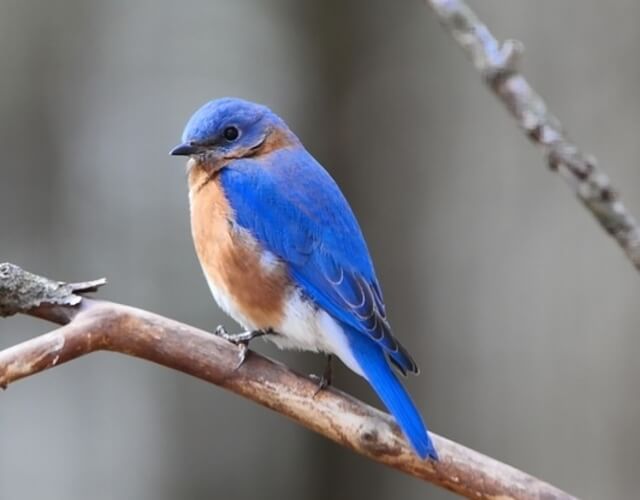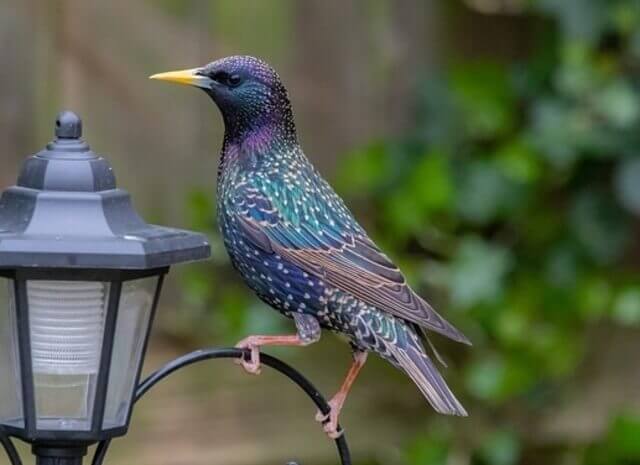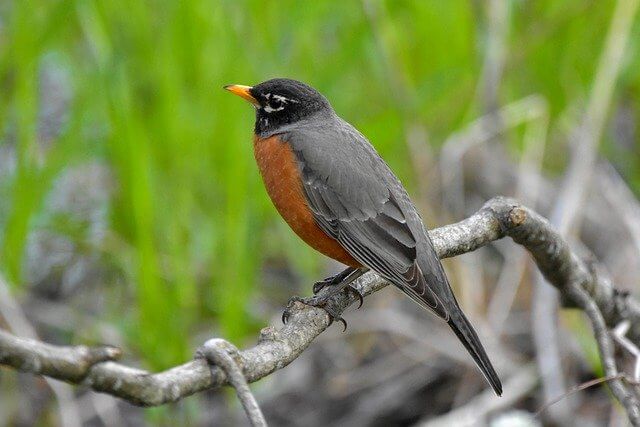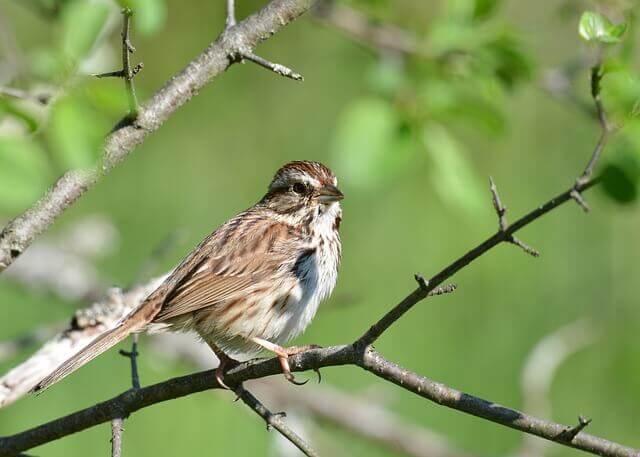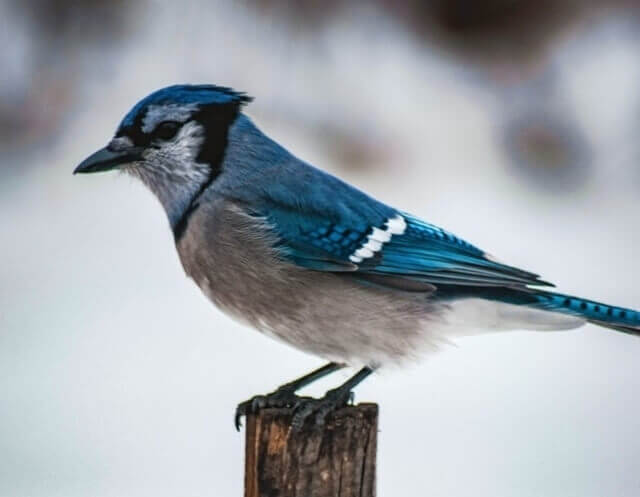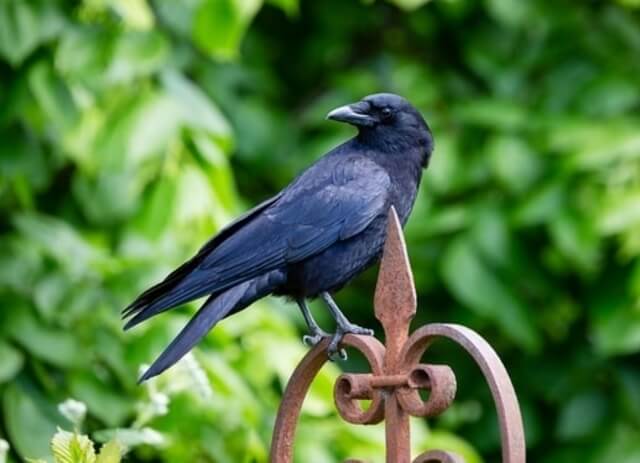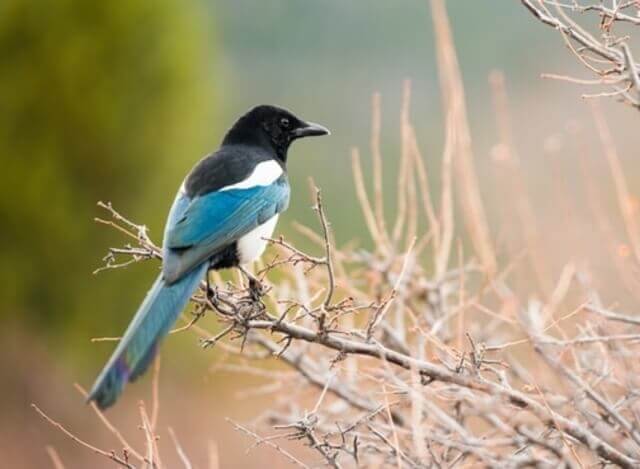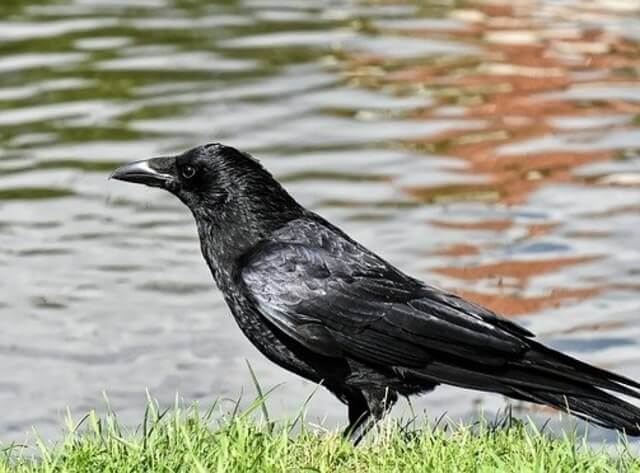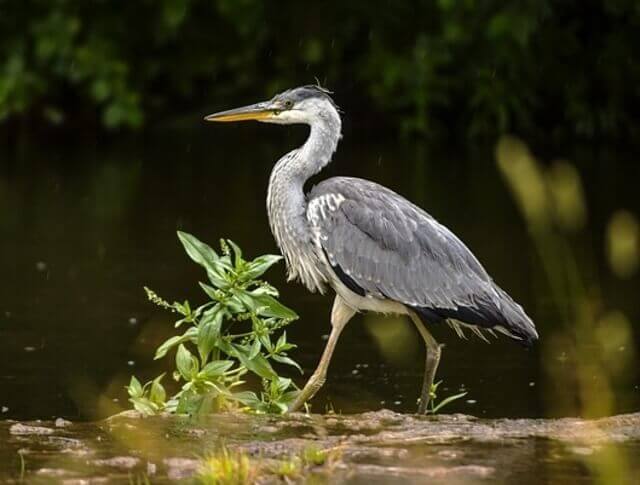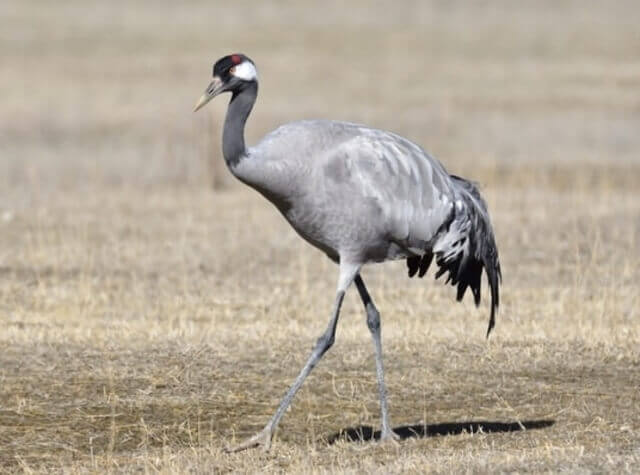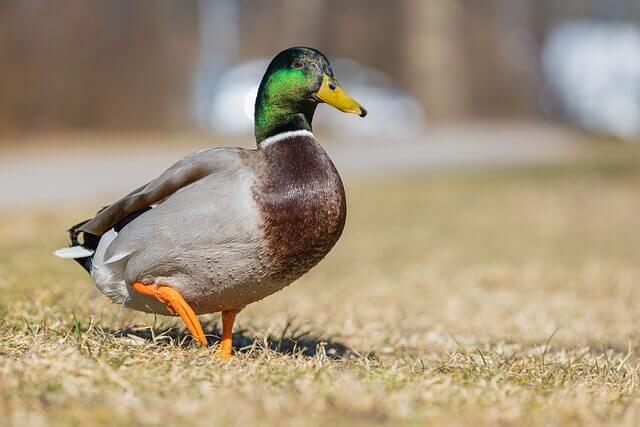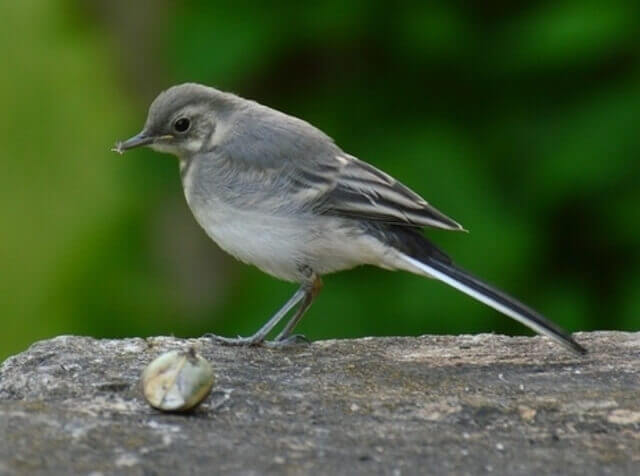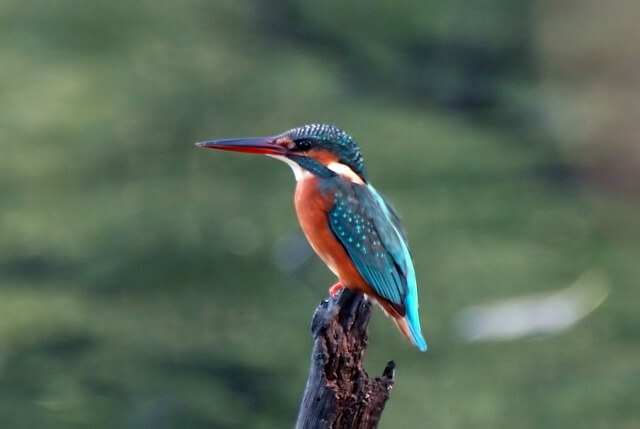Welcome to “18 Birds That Eat Snails,” your comprehensive guide into the fascinating world of avian snail enthusiasts. Join us as we explore their diverse hunting techniques, ecological impact, and much more. Whether you’re a birdwatcher or a nature lover, prepare to be amazed by these snail-loving birds.
Table of Contents
- 1 Types of Birds That Eat Snails
- 2 Snail-Eating Techniques
- 3 Ecological Impact
- 4 Avian Dispersal of Snails
- 5 Snail Species Consumed
- 6 Snail Predation in Different Habitats
- 7 Snail Diet Adaptations
- 8 Conservation Efforts
- 9 Snails as a Food Source
- 10 Birding Tips for Observing Snail-Eating Birds
- 11 References:
- 12 Author
Types of Birds That Eat Snails
Bluebirds
Bluebirds are interesting birds that are common in North America. They are found in broadleaf deciduous forests and woodlands in the eastern and central regions of the continent. They also inhabit parts of the western United States and Canada.
Their diet consists of mainly small insects, bugs, snails and berries. They also eat some seeds and plants to help them survive. One of their favorite foods is the larvae of lepidoptera. They can also be found in trees, shrubs and fields.
Blackbirds
The Common Blackbird, a member of the thrush family, can be spotted across the United States, except in the Southwest and California, extending its range into Canada and Mexico. Its preferred habitat typically encompasses areas adjacent to water sources like marshes, ponds, streams, and regions adorned with trees and bushes.
This bird is known for its migratory behavior, making appearances during the spring and fall seasons. Its dietary preferences predominantly consist of insects, worms, berries, and seeds, with occasional indulgence in snails.
Starlings
Starlings are small birds that usually stay close to human settlement areas. There are around 120 different species of starlings. They are mainly found in Europe, Asia, North America and Africa.
They have a large range of habitats that can include large forests, grasslands, farmland, as well as urban and suburban areas. Starlings mainly feed on insects, snails, seeds and fruits. They are known to be very opportunistic feeders that can eat anything they find.
Robins
Two distinct species of robins exist: the American Robin and the European Robin. While the American Robin predominates in North America, its European counterpart is the prevalent species across Europe. The European Robin demonstrates remarkable adaptability, thriving in diverse habitats, with a significant portion of the population residing in woodlands and farmland.
In terms of diet, these robins exhibit some variations. European Robins consume a wide array of sustenance, including small invertebrates, various seeds, berries, and select fruits. On the other hand, American Robins are versatile in their habitat choices, often favoring proximity to water bodies. Their diet primarily consists of fruits, berries, and insects.
Sparrows
Sparrows are a type of bird. They are found throughout the world, except for the Arctic, Antarctica, and some of the high mountain ranges. They are generally found in open areas, and are often the first bird species to appear in the spring. Sparrows have pointed wings and are very small.
They are mostly brown and have a mottled pattern. Sparrows have a very small and light bill. They are omnivores, and will eat insects, seeds, berries, and snails. Sparrows are a good bird to look at, as they are often seen in parks and gardens.
Blue Jays
The Blue Jay is a medium-sized bird with a brilliant blue plumage that is a member of the Corvid family. It is a common bird in North America. It is found in the eastern United States and Canada. Their range is throughout North America, but they are not common in the southern United States.
The Blue Jay eats worms, insects, acorns, snails and small animals. They are known to eat squirrels, mice and other small mammals. They can also eat eggs and chicks. The Blue Jay has a lifespan of up to 7 years in the wild.
Crows
Crows are a highly adaptable bird species found across North America, Europe, Asia, and Africa. In North America, the American crow is known for its versatility, inhabiting a wide range of environments, from dense forests to open grasslands.
Their dietary preferences are diverse, encompassing insects, small vertebrates, and scavenged carrion. Some researchers have suggested that American crows might incorporate snails into their diet to access specific nutrients not typically found in their usual food sources.
Magpies
The Magpie is a bird that is found in parts of North America, Europe, Asia and Australia. They can typically be seen in parks, gardens and forests. These birds are just as intelligent as they are beautiful. They are well known for their ability to mimic each other.
They have also been known to imitate sounds such as the car alarm. As for their diet, the magpie eats a variety of things. The most common food for these birds are snails, insects, seeds, nuts, berries and some small mammals.
Ravens
Ravens are a type of bird of prey that live in both the northern and southern hemispheres. They are found in forests, open areas, near water, marshlands, forests, and deserts. Ravens are omnivores, meaning they can eat meat and plant matter.
They get their name from their habit of eating carrion. They also eat small animals, snails, eggs, insects, and even small mammals. A raven’s diet may vary depending on the location in which they live. In general, they will eat anything they can find.
Hawks
Hawks, formidable raptors, are widely distributed across North America, Europe, and Asia, with occasional appearances in Africa. These versatile birds are equally at home on the ground or perched in trees, often employing aerial tactics to pounce on unsuspecting prey from above.
Hawks are sharp-eyed predators, primarily hunting by sight. Their extensive menu features a variety of prey, such as mammals, birds, reptiles, amphibians, and invertebrates. These adaptable birds thrive in diverse habitats, from woodlands and parklands to agricultural areas, and their diet might even encompass snails and slugs.
Herons
Herons, classified within the heron order, constitute a unique family of wading birds due to their primarily carnivorous diet. This family exhibits migratory behavior, with breeding populations inhabiting temperate regions in the Northern Hemisphere and some members residing year-round in tropical environments.
Their diet primarily consists of frogs, fish, crabs, snails, aquatic insects, and small mammals. Globally, there are 72 recognized species of Herons, yet the United Kingdom hosts only three of these species. Notably, many Herons are known to nest and live in colonies, further emphasizing their social behavior.
Storks
Storks, a diverse family of passerine birds found across multiple continents worldwide, are characterized by their distinctive long legs and slender, needle-like bills. Their diet primarily consists of fish, snails, amphibians, reptiles, and earthworms. Storks are known for their gregarious nature, often congregating in flocks.
These birds construct their nests in concealed spots, either in trees or on the ground. Their nests are typically robust, built with sticks and lined with a mixture of mud, feathers, or felted vegetation. Unfortunately, storks face significant threats from human activities, resulting in a decline in their populations. This decline is largely attributed to factors like habitat destruction, disturbances, and hunting.
Cranes
The Crane, known for its imposing presence, stands tall, often surpassing four feet in height, with a majestic wingspan that can reach up to eight feet. These impressive birds inhabit extensive territories, including regions across Europe, Western Asia, Northern Africa, and even parts of North America, where both the Whooping Crane and Sandhill Crane can be found.
These magnificent birds prefer open environments graced with scattered trees, making meadows, marshes, and serene ponds their favored abodes. Their eclectic diet includes insects, small reptiles, amphibians, and the occasional indulgence in snails. The Crane’s wide distribution and diverse feeding habits contribute to the intricate web of avian life on multiple continents.
Ducks
The Duck, a waterfowl species with a wide distribution spanning across North America and Eurasia, is the most prevalent among the Mallard ducks. Initially domesticated in Europe, these ducks predominantly inhabit aquatic environments but also explore terrestrial foraging. Their adaptability is evident in the diverse range of habitats they call home, from expansive open water bodies to wetlands and wooded areas.
These omnivorous birds have a varied diet that encompasses plant and animal matter. Their primary food sources include fish, frogs, crayfish, snails, insects, seeds, crustaceans, aquatic plants, roots, and fungi. Ducks are highly sociable creatures, often forming large groups in their natural habitats.
Geese
Geese are highly adaptable birds with a global presence. They inhabit a diverse array of ecosystems, spanning continents and encompassing wetlands, forests, farmlands, and more. As omnivorous creatures, geese display an eclectic palate, savoring a wide range of both plant and animal fare. Their voracious appetite drives them to explore a variety of food sources, but one delicacy that particularly entices them is snails.
These remarkable birds are not confined to a single region but are widespread throughout the world, establishing their homes in places as diverse as Canada, Europe, Asia, and numerous other continents. Their ability to thrive in such varied habitats showcases their adaptability and widespread distribution.
Limpkins

Limpkins are an intriguing bird species native to the Australian Outback. They stand out as a unique type of finch with a habitat range spanning from arid deserts to lush tropical rainforests. Among the avian inhabitants of Australia, the Limpkin holds the distinction of being one of the few known to include snails in its diet.
Although snails are part of the Limpkin’s diet, they are not the bird’s primary food source. Snails constitute a relatively small portion of their overall dietary intake. Instead, these birds primarily subsist on a diet consisting of grass seeds, flowers, and insects. In the wild, Limpkins face predation from a variety of threats, including snakes, hawks, and owls.
Gray Wagtail
The Gray Wagtail, characterized by its sleek physique, exhibits striking features, including a pristine white throat and a coat of dark gray plumage. Its dietary preferences predominantly revolve around insects and various invertebrates, encompassing creatures like spiders, worms, and snails.
This charming bird’s habitat stretches across a vast expanse, reaching from North Africa to the northern reaches of Scandinavia, with its heartland being in Europe and Asia. While North America also hosts sightings of Gray Wagtails, they are relatively less common in this region. You can spot them thriving in diverse landscapes such as riverbanks, lakeshores, marshes, and agricultural lands as long as there’s a water source nearby.
Common Kingfisher
Kingfishers have a wide geographical range, spanning from the Mediterranean Sea in the west to the Indus River in the east, encompassing approximately 1.3 million square kilometers. Additionally, they can be sighted in the eastern and southern regions of the United States.
While Kingfishers belong to a cosmopolitan family of birds found across the globe, they predominantly inhabit subtropical or tropical moist montane forests. Their diet primarily consists of insects and other small creatures, although they also include snails in their culinary preferences.
Snail-Eating Techniques
Birds that specialize in snail consumption have developed unique hunting strategies to overcome the challenges presented by these mollusks.
1. Picking and Pecking: Several bird species, such as sparrows and blackbirds, employ the technique of picking and pecking to extract snails from their shells. They use their sharp beaks to break open the shells, revealing the succulent snail within. This method requires precision and patience.
2. Probing and Foraging: Birds like herons and storks, often found in wetland environments, are adept at probing and foraging for aquatic snails. They use their long bills to probe the mud or shallow waters, searching for submerged snails. Once located, they swiftly capture their prey.
3. Crushing and Pounding: Some birds, including crows and ravens, possess strong bills capable of crushing snail shells. They may take advantage of elevated perches or hard surfaces to pound snail shells open, gaining access to the soft snail flesh.
4. Territorial Exploration: Tree-dwelling snail-eating birds like blue jays are known for their territorial exploration. They navigate through branches and foliage, systematically searching for tree-dwelling snails.
5. Sifting and Filtering: Ducks and geese, which frequent freshwater habitats, use a sifting technique to extract freshwater snails. They submerge their heads in the water, sifting through sediment and vegetation to locate snails, which are then filtered from the water.
6. Agile Hunting: Birds like hawks and falcons, known for their speed and agility, employ dynamic hunting strategies. They engage in aerial pursuits, chasing down terrestrial or arboreal snails with precision and speed.
7. Patience and Observation: Certain snail-eating birds exhibit a patient and observant approach. They may remain still, carefully observing their surroundings for snail activity, before making a calculated move to capture their prey.
8. Seasonal Variations: Snail availability and behavior can vary seasonally, influencing bird feeding patterns. Birds adapt to these changes, with some species focusing more on snails during particular times of the year when snail populations are abundant.
9. Group Foraging: In some cases, birds engage in group foraging, especially when hunting snails in large quantities. This behavior can be observed in species like gulls that congregate at feeding sites with ample snail resources.
By exploring these snail-eating techniques, we gain a deeper appreciation for the adaptability and resourcefulness of avian species. These unique hunting strategies highlight the intricate relationships between birds and their prey, ultimately contributing to the complex web of life within ecosystems.
Ecological Impact
In discussing the ecological impact of birds that prey on snails, it becomes evident that these avian species serve a vital role in maintaining the balance of local ecosystems. By controlling snail populations, these birds influence various ecological aspects.
- Population Control: Snails, known for their prolific reproduction rates, can quickly become pests in gardens and agricultural areas. Birds, such as starlings, sparrows, and crows, act as natural population control agents. They help mitigate the overabundance of snails, thereby reducing the damage these mollusks can inflict on crops and vegetation.
- Biodiversity Preservation: Snails feed on a range of plant materials, and their unchecked populations can affect local plant life. This, in turn, can have a cascading effect on other species. By keeping snail populations in check, snail-eating birds contribute to preserving the biodiversity of an ecosystem.
- Habitat Maintenance: The presence of these birds in various ecosystems ensures the health of those habitats. For instance, herons, which frequent wetlands and marshes in search of snails, help maintain these environments by preventing snail overgrazing on aquatic vegetation.
- Disease Control: Snails can act as hosts for various parasites, including those harmful to humans. Snail-eating birds indirectly contribute to disease control by reducing snail populations and, consequently, limiting the prevalence of these parasites.
- Nutrient Cycling: The consumption of snails by various bird species forms part of the nutrient cycling process. When birds prey on snails and later excrete waste, they return valuable nutrients to the ecosystem, enriching the soil and promoting plant growth.
- Predator-Prey Relationships: Snail-eating birds are integral to the intricate web of predator-prey relationships in ecosystems. Their presence influences not only the snail populations but also the distribution and abundance of species further up the food chain.
- Behavioral Patterns: The interaction between snail-eating birds and snails has shaped unique behavioral patterns in both predator and prey. These interactions contribute to the rich tapestry of behaviors observed in nature.
Understanding the ecological impact of snail-eating birds emphasizes their importance in the broader context of ecosystem dynamics. As natural controllers of snail populations, these birds actively contribute to the well-being and sustainability of the environments they inhabit.
Avian Dispersal of Snails
Within the realm of avian snail dispersal, it’s worth noting that certain snail species can surprisingly benefit from bird predation. In a study published in the “Journal of Biogeography” in 2011, conducted by Shinichiro Wada et al., evidence of snail survival during their passage through a bird’s digestive system emerged.
The researchers carried out experiments involving land snails (Tornatellides boeningi) and two distinct bird species: Japanese white-eyes (Zosterops japonicus) and brown-eared bulbuls (Hypsipetes amaurotis).
Amid these fascinating discoveries, Darwin’s groundbreaking ideas on the subject come to mind. In the book “On the Origin of Species,” he proposed an intriguing concept – that birds might play a pivotal role in dispersing snails and other aquatic life.
This notion gained further traction with the explorations of Harry Wallis Kew in 1893, who delved into the external transport of these creatures facilitated by birds.
Lyell observed that waterfowl could transport snail eggs on their feathers. Reverend Canon Tristram even uncovered evidence of snail eggs on a mallard’s foot in the Sahara, raising questions about whether certain snails should be classified as freshwater or land snails, considering their habitat.
Additionally, Darwin postulated that baby snails might hitch rides on birds’ feet, although this theory currently lacks substantial supporting evidence. However, the most captivating possibility he proposed is the internal transport of organisms within birds.
Snails, it seems, can endure the journey through a bird’s digestive system and potentially be released later. For example, Mr. W. H. Dikes discovered multiple snail specimens in a bearded titmouse’s crop, and remarkably, living snails were found even hours after a bird’s demise.
This phenomenon gains further credence when considering certain snails like Hydrobia ulvae, which have demonstrated the ability to survive a bird’s digestive tract. Even terrestrial snails, such as Tornatellides boeningi, were successfully recovered alive in the feces of birds they were fed to.
These instances underscore the remarkable resilience of these creatures, providing a fascinating dimension to the interaction between avian predators and snails.
Snail Species Consumed
Snail-eating birds exhibit remarkable adaptability in their diet, often consuming a wide range of snail species. The diversity of snail species they feed on can vary, depending on factors such as geographic location and habitat. Here, we delve into the snail species commonly consumed by these avian predators and explore potential variations in their diet.
1. Land Snails: Many birds, including blackbirds, starlings, and sparrows, frequently target land snails, which can be found in a variety of terrestrial environments. These snails are typically slower-moving, making them accessible prey for birds.
2. Aquatic Snails: Birds inhabiting wetland areas, such as herons, ducks, and geese, often incorporate aquatic snails into their diet. These snails are adapted to aquatic environments, and the birds skillfully extract them from the water.
3. Tree Snails: Some bird species, like blue jays and crows, are known to forage for tree-dwelling snails. These snails may inhabit the bark, branches, or foliage of trees, and the birds use their dexterity to locate and capture them.
4. Garden Snails: Common garden snails are a favored delicacy for a variety of snail-eating birds. Robins, in particular, are known to seek out these snails in gardens and cultivated areas.
5. Helicid Snails: The Helicidae family of land snails includes numerous species, some of which are preferred prey for snail-eating birds. These snails vary in size, shape, and habitat preferences, and birds adapt their hunting techniques accordingly.
6. Ramshorn Snails: Ramshorn snails, known for their coiled shells resembling ram’s horns, may also be on the menu for certain bird species. Their prevalence in aquatic habitats makes them a potential food source for birds frequenting such areas.
7. Freshwater Snails: Birds like ducks and herons that inhabit freshwater ecosystems often feed on a variety of freshwater snail species, contributing to the regulation of these populations.
8. Terrestrial and Arboreal Snails: The diet of snail-eating birds can include snails living in diverse terrestrial and arboreal environments. The adaptability of these birds allows them to explore different niches for snail prey.
It’s essential to note that while there is a considerable overlap in the snail species consumed by these birds, variations can exist based on factors like geographical location, seasonal changes, and local snail availability.
Snail Predation in Different Habitats
Birds that feed on snails demonstrate remarkable adaptability in their snail-feeding techniques across diverse environments. Their behavior is highly influenced by the specific habitats they inhabit, enabling them to maximize their hunting efficiency.
- Wetlands: In wetland ecosystems, you’ll find birds like herons and storks. These long-legged waders are equipped with slender, pointed bills, which they skillfully deploy to snatch aquatic snails and other aquatic prey. Their slow, deliberate movements in shallow water allow them to capture snails without disturbing the aquatic environment.
- Forests: Forest-dwelling birds, such as thrushes and certain species of woodpeckers, have adapted to a terrestrial snail-hunting strategy. They forage on the forest floor, turning over leaves and debris to uncover hidden snails. Some woodpeckers are known to drum on tree trunks, enticing snails to the surface for an easy meal.
- Urban Areas: In urban environments, pigeons and doves have adapted to coexisting with human activities. They are opportunistic feeders that may consume garden snails and other food scraps. This adaptability showcases how certain bird species navigate the challenges of urban living.
- Shorelines and Coastal Areas: Coastal bird species like seagulls and sandpipers have evolved their snail-feeding techniques to suit intertidal zones. Here, they probe the wet sand and mud, extracting snails and other invertebrates. Their feeding behavior coincides with the tidal cycles.
- Open Fields and Grasslands: Birds like the meadowlark that inhabit open fields and grasslands use a combination of probing and pecking techniques. Their sharp bills are well-suited for extracting snails from the soil, an essential part of their diet in these open environments.
Snail Diet Adaptations
Birds that rely on snails as a dietary staple exhibit a range of fascinating adaptations that optimize their efficiency as snail hunters. These adaptations showcase the remarkable evolutionary strategies these birds have developed over time:
- Specialized Bills: Many snail-eating birds possess specialized bills, often curved or pointed, designed to facilitate prying snails from their protective shells. These bills allow for precise manipulation when extracting snails.
- Digestive Adaptations: Birds consuming snails must contend with the calcium-rich shells. To overcome this challenge, their digestive systems are equipped to effectively dissolve and process these shells. This specialized digestion ensures that they can extract the maximum nutritional value from their snail prey.
- Seasonal Diet Variation: Some bird species demonstrate a degree of dietary flexibility. They adapt to changing food availability by incorporating snails into their diet when other prey becomes scarce. This adaptation helps them maintain their nutritional needs, especially during periods of limited food resources.
Conservation Efforts
Conservation efforts are vital to safeguard the snail-eating birds and their intricate ecosystems. Although these birds often thrive in various habitats, they can face challenges due to habitat loss, pollution, and changing climate patterns. To protect these remarkable avian species and the snails they rely on, several initiatives are in place.
1. Habitat Preservation: Preserving diverse habitats, from wetlands to forests, is crucial for these birds’ survival. Protected areas, national parks, and wildlife reserves help maintain suitable environments for snail-eating birds.
2. Pollution Control: Efforts to reduce water and habitat pollution play a vital role in protecting both snails and their avian predators. Stricter regulations and pollution management strategies are implemented to ensure healthier ecosystems.
3. Climate Change Mitigation: Climate change affects the distribution of both snails and birds. Conservationists work on mitigating the effects of climate change to ensure these species can adapt to new conditions.
4. Nesting and Roosting Sites: Providing safe nesting and roosting sites helps maintain healthy populations. Installing nest boxes and preserving natural roosting areas can boost their numbers.
5. Public Awareness: Educating the public about the ecological importance of these birds and their interconnectedness with snail populations encourages conservation efforts.
Collaborative actions among conservation organizations, researchers, and the public are essential to ensure the continued well-being of these unique snail-eating birds.
These initiatives aim to preserve these avian species’ diversity and contribute to the overall health of their ecosystems.
Snails as a Food Source
Snails provide a nutritional source for birds. They are high in protein and calcium, essential for egg formation. While some birds rely on snails as a primary food source, others consume them seasonally or as supplementary nutrition. Understanding the nutritional value of snails illuminates their importance in these birds’ diets.
Snail protein and amino acid content exhibit significant variations based on the snail’s species and its habitat. Typically, snail protein constitutes a range of 20% to 60% of their dry weight, with variations among species. Additionally, snails contain essential amino acids, including lysine, methionine, threonine, and tryptophan.
Here’s a table presenting the protein and amino acid content for three distinct snail species:
| Snail Species | Protein Content (%) | Amino Acid Composition (% of Proteins) | Habitat |
|---|---|---|---|
| Helix Pomatia | 45.7 | Lysine: 3.97, Methionine: 1.21, Threonine: 2.38, Tryptophan: 0.54 | Woodlands, Europe |
| Achatina Fulica | 35-50% | Lysine: 2-3%, Methionine: 0.3-0.4%, Threonine: 1-1.5%, Tryptophan: N/A | Subtropical regions |
| Cornu Aspersum | ~20% | Lysine: N/A, Methionine: N/A, Threonine: N/A, Tryptophan: N/A | Gardens, Worldwide |
Birding Tips for Observing Snail-Eating Birds
Observing snail-feeding birds requires patience and knowledge of their habitats and behavior. Ideal locations include wetlands, forests, and gardens. Early mornings and late afternoons are often the best times to spot them. Carrying binoculars and field guides specific to your region can enhance the birdwatching experience. Consider joining local birdwatching groups for shared insights and sightings.
References:
- Biggs, H. E. J. (1968). Succinea putris (L.) in a pigeon’s crop. Conchologist Newsletter, 24, 36.
- Cadée, G. (2011). Hydrobia as “Jonah in the whale”: shell repair after passing through the digestive tract of shelducks alive. Palaios, 26(4), 245-249. DOI: 10.2110/palo.2010.p10-095r
- Darwin, C. R. (1859). On the Origin of Species. [Read the book here.]
- Kew, H. W. (1893). The dispersal of shells: an inquiry into the means of dispersal possessed by fresh-water and land Mollusca. K. Paul, Trench, Trübner & Co., Ltd. [Read the book here.]
- Wada, S., Kawakami, K., & Chiba, S. (2011). Snails can survive passage through a bird’s digestive system. Journal of Biogeography. DOI: 10.1111/j.1365-2699.2011.02559.x


